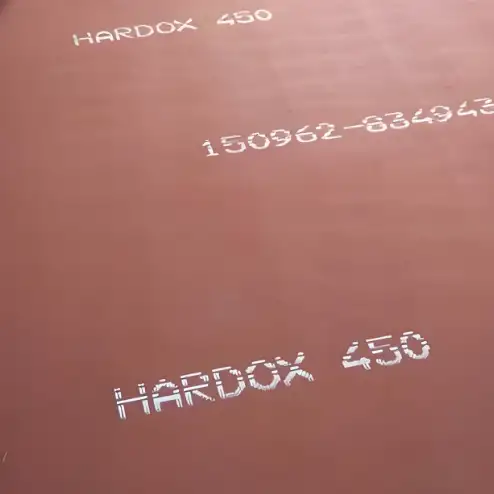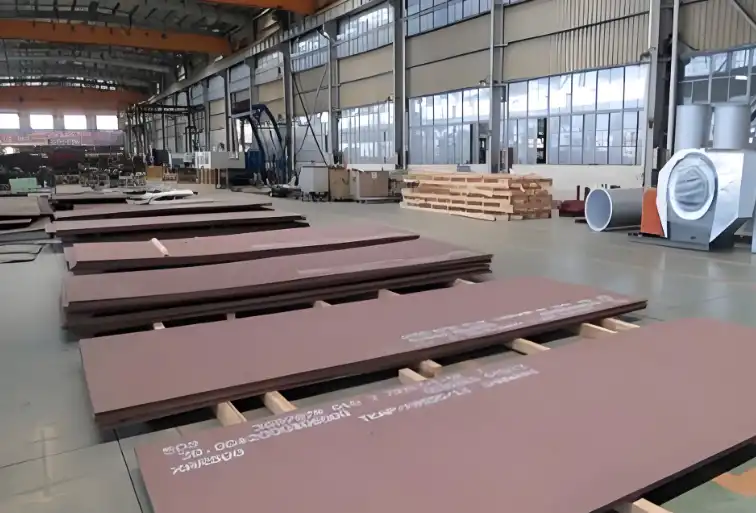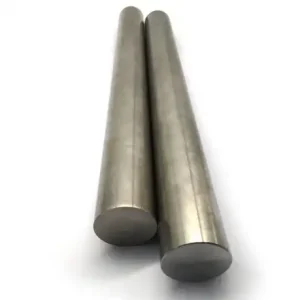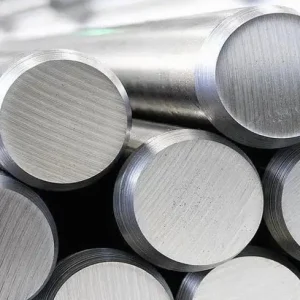Hardox 450 steel wear plate represents one of the most versatile and widely adopted abrasion-resistant materials in modern industrial applications. With a nominal hardness of 450 HBW and exceptional toughness characteristics, this premium wear plate material delivers outstanding performance in demanding environments where traditional steels fail to meet operational requirements.
What is Hardox 450 Material?
Hardox 450 belongs to the family of abrasion-resistant steels manufactured by SSAB, designed specifically for applications requiring superior wear resistance combined with good weldability and formability. This quenched and tempered steel plate achieves its remarkable properties through controlled chemical composition and precise heat treatment processes.
The material exhibits a unique microstructure consisting of tempered martensite, which provides the optimal balance between hardness and toughness. Unlike conventional high-carbon steels that become brittle at high hardness levels, Hardox 450 maintains structural integrity under impact loading conditions.
Manufacturing processes for Hardox 450 involve sophisticated metallurgical techniques including vacuum degassing, continuous casting, and computer-controlled quenching systems. These advanced production methods ensure consistent quality and reliable performance across different plate thicknesses and dimensions.
Please note that we are not an authorized distributor or representative of SSAB for Hardox® products. As such, we are currently not offering Hardox® 450 plate for sale.
For customers seeking a material with similar properties and performance, we highly recommend the following equivalent alternatives:
Both NM450 and AR450 provide excellent abrasion resistance and mechanical strength, making them suitable for applications where durability and wear resistance are critical. These products are readily available and can serve as direct replacements for Hardox® 450 in many cases.
What is the Chemical Composition of hardox 450?
The chemical composition of Hardox 450 steel is carefully engineered to achieve optimal mechanical properties while maintaining excellent weldability characteristics.
| Element | Percentage (%) | Function |
|---|---|---|
| Carbon (C) | 0.14-0.20 | Hardness and strength enhancement |
| Silicon (Si) | 0.70 max | Deoxidation and strength improvement |
| Manganese (Mn) | 1.60 max | Hardenability and toughness |
| Phosphorus (P) | 0.025 max | Controlled for weldability |
| Sulfur (S) | 0.010 max | Minimized for ductility |
| Chromium (Cr) | 1.20 max | Wear resistance and hardenability |
| Nickel (Ni) | 1.50 max | Toughness improvement |
| Molybdenum (Mo) | 0.60 max | Strength and hardenability |
| Boron (B) | 0.005 max | Hardenability enhancement |
The precise control of these alloying elements enables Hardox 450 to achieve its target hardness range while maintaining the necessary toughness for practical applications.
What are the Mechanical Properties of Hardox 450?
The mechanical properties of Hardox 450 steel demonstrate exceptional performance characteristics that make it suitable for demanding industrial applications.
| Property | Value | Test Method |
|---|---|---|
| Hardness | 425-475 HBW | EN ISO 6506-1 |
| Yield Strength | 1200 MPa min | EN ISO 6892-1 |
| Tensile Strength | 1400 MPa min | EN ISO 6892-1 |
| Elongation | 8% min | EN ISO 6892-1 |
| Impact Energy (20°C) | 25 J min | EN ISO 148-1 |
| Impact Energy (-40°C) | 18 J min | EN ISO 148-1 |
These properties remain consistent across various plate thicknesses, with slight variations depending on the specific dimensions and heat treatment parameters.
What is the specification of Hardox 450?
Hardox 450 steel plates are manufactured according to strict international standards and specifications to ensure consistent quality and performance.
| Specification | Standard | Description |
|---|---|---|
| Thickness Range | 4-80 mm | Standard production range |
| Width | Up to 3150 mm | Maximum available width |
| Length | Up to 12000 mm | Standard maximum length |
| Flatness Tolerance | ±3 mm/m | Surface flatness specification |
| Thickness Tolerance | ±0.3 mm | For plates ≤20 mm |
| Edge Condition | Mill edge or cut edge | As per customer requirements |
| Surface Condition | Shot blasted | Standard surface preparation |
Additional specifications can be provided based on specific customer requirements and application needs.
What Does Hardox 450 Stand For?
The designation "Hardox 450" follows a systematic naming convention where "Hardox" represents the brand name for SSAB's wear-resistant steel products, and "450" indicates the nominal hardness value in Brinell hardness units (HBW).
This naming system provides immediate identification of the material's primary characteristic - its hardness level. The number 450 specifically refers to the typical hardness range of 425-475 HBW that the material achieves after proper heat treatment.
The Hardox brand encompasses a complete range of wear-resistant steels, from Hardox 400 to Hardox 600, each designed for specific application requirements and operating conditions.
What is the equivalent of Hardox 450?
Several equivalent materials exist in the global market that offer similar properties and performance characteristics to Hardox 450.
| Brand | Grade | Manufacturer | Hardness (HBW) |
|---|---|---|---|
| AR450 | AR450 | Various | 425-475 |
| Raex 450 | Raex 450 | Ruukki | 425-475 |
| Quard 450 | Quard 450 | ThyssenKrupp | 425-475 |
| XAR 450 | XAR 450 | ThyssenKrupp | 425-475 |
| Abrazo 450 | Abrazo 450 | Dillinger | 425-475 |
| WEL-HARD 450 | WEL-HARD 450 | JFE | 425-475 |
While these materials share similar hardness ranges, subtle differences in chemical composition and manufacturing processes may result in variations in specific properties such as impact toughness and weldability.
What is the difference between Hardox 450 and AR 450?
Although Hardox 450 and AR 450 share similar hardness specifications, several key differences distinguish these materials in terms of quality, consistency, and performance.
| Aspect | Hardox 450 | AR 450 |
|---|---|---|
| Manufacturing Standard | SSAB proprietary | ASTM A514 |
| Quality Control | Premium grade | Standard grade |
| Chemical Composition | Tightly controlled | Broader ranges |
| Impact Toughness | Guaranteed minimum | Variable |
| Weldability | Excellent | Good |
| Surface Quality | Superior finish | Standard finish |
| Price Range | Premium pricing | Competitive pricing |
The superior quality control and manufacturing processes used for Hardox 450 result in more consistent properties and better overall performance in critical applications.
Applications of Hardox 450
Hardox 450 steel wear plates find extensive applications across multiple industries where abrasive wear represents a significant operational challenge.
Mining and quarrying operations utilize Hardox 450 for dump truck bodies, conveyor chutes, and crusher components. The material's excellent impact resistance makes it ideal for handling heavy ore loads and abrasive materials.
Construction equipment manufacturers incorporate Hardox 450 in excavator buckets, bulldozer blades, and loader cutting edges. The combination of hardness and toughness ensures extended service life under severe working conditions.
Recycling industry applications include shredder hammers, conveyor systems, and sorting equipment components. The material's resistance to impact and abrasion proves essential for processing scrap metal and other recycled materials.
Agricultural machinery benefits from Hardox 450 in tillage tools, harvester components, and manure spreaders where soil abrasion and impact loading occur frequently.
What is the classification of Hardox 450?
Hardox 450 classification encompasses various technical standards and industry specifications that define its properties and applications.
| Classification System | Category | Designation |
|---|---|---|
| EN 10025-6 | Structural Steel | S460MC |
| ASTM | High Strength Steel | A514 Grade Q |
| JIS | Abrasion Resistant | JFE-EH450 |
| DIN | Wear Resistant | 1.8909 |
| ISO | International Standard | ISO 4952 |
| SSAB Internal | Hardox Series | Hardox 450 |
These classifications ensure proper material identification and application across different international markets and regulatory frameworks.
Understanding Hardox Grade System
| Hardox® Grade | Hardness (HBW) | Yield Strength (MPa, min) | Thickness Range (mm) | Product Type | Equivalent Standard |
|---|---|---|---|---|---|
| Hardox® 400 | 370-430 | 1000 | 3-130 | Wear Plate | EN 15220:2006 |
| Hardox® 450 | 425-475 | 1200 | 3-100 | Wear Plate | AS 2027:2019 |
| Hardox® 500 | 470-530 | 1400 | 3-80 | Wear Plate | ASTM A128 |
| Hardox® 550 | 530-580 | 1550 (QT) / 1650 (TMT) | 3-50 | Quenched & Tempered | ISO 4957 |
| Hardox® 600 | 570-640 | 1800 | 3-30 | Thermo-Mechanically Treated | EN 10027-2 |
| Hardox® Extreme™ | 650-750 | 2200 | 3-15 | Ultra-High Strength | Proprietary |
| Hardox® HiTuf® | 350-440 | 1000 | 3-100 | Impact-Resistant | EN 10088-2 |
| Hardox® Struct® 500 | 460-540 | 1350 | 3-80 | Structural Wear Steel | EN 10025-6 |
Corrosion Resistance of Hardox Steel
Hardox 450 steel exhibits moderate corrosion resistance typical of low-alloy steels, requiring appropriate protective measures in corrosive environments.
The material's corrosion behavior depends on environmental factors including humidity, temperature, chemical exposure, and atmospheric conditions. In dry environments, natural oxide formation provides limited protection against further corrosion.
Surface treatments such as painting, galvanizing, or specialized coatings significantly improve corrosion resistance for applications in harsh environments. Shot blasting preparation ensures optimal coating adhesion and long-term protection.
Proper design considerations including drainage, ventilation, and maintenance access help minimize corrosion risks during service life.
Strength Comparison with Standard Steel
Hardox 450 demonstrates significantly superior strength characteristics compared to conventional structural steels, making it highly suitable for demanding applications.
Standard mild steels typically exhibit yield strengths of 250-400 MPa, while Hardox 450 achieves minimum yield strength of 1200 MPa - representing a three-fold improvement in load-bearing capacity.
The high strength-to-weight ratio enables substantial weight reduction in equipment design while maintaining structural integrity. This advantage translates to improved fuel efficiency, increased payload capacity, and reduced operating costs.
However, the increased strength requires careful consideration of design factors including stress concentrations, fatigue behavior, and joining techniques to realize full material potential.
Global Market Pricing for Hardox 450 Steel Wear Plate 2025
Current market pricing for Hardox 450 steel wear plate varies significantly across different regions and suppliers, influenced by raw material costs, manufacturing capacity, and local demand.
| Region | Price Range (USD/MT) | Market Conditions |
|---|---|---|
| North America | 1,800-2,200 | Strong demand, limited supply |
| Europe | 1,650-2,000 | Stable market, competitive pricing |
| Asia-Pacific | 1,500-1,850 | High volume, price sensitive |
| Middle East | 1,750-2,100 | Project-driven demand |
| South America | 1,600-1,950 | Commodity market influence |
| Africa | 1,700-2,050 | Import-dependent pricing |
Price fluctuations occur due to raw material costs, energy prices, transportation expenses, and currency exchange rates affecting global trade patterns.
Size and Weight Parameters for Hardox 450 Steel Wear Plate
Standard dimensions and weight specifications for Hardox 450 steel wear plates accommodate diverse application requirements across multiple industries.
| Thickness (mm) | Width (mm) | Length (mm) | Weight (kg/m²) |
|---|---|---|---|
| 6 | 2000 | 6000 | 47.1 |
| 8 | 2500 | 8000 | 62.8 |
| 10 | 3000 | 10000 | 78.5 |
| 15 | 2000 | 6000 | 117.8 |
| 20 | 2500 | 8000 | 157.0 |
| 25 | 3000 | 10000 | 196.3 |
| 30 | 2000 | 6000 | 235.5 |
| 40 | 2500 | 8000 | 314.0 |
| 50 | 3000 | 10000 | 392.5 |
Custom dimensions can be produced according to specific customer requirements, subject to manufacturing capabilities and minimum order quantities.
Advantages of Hardox 450 Steel Wear Plate
Hardox 450 offers numerous advantages that make it the preferred choice for wear-resistant applications across diverse industries.
Superior wear resistance significantly extends component service life, reducing maintenance frequency and associated downtime costs. The material's exceptional hardness provides effective protection against abrasive wear mechanisms.
Excellent weldability enables easy fabrication and repair operations using standard welding procedures. The material accepts various welding processes including SMAW, GMAW, and SAW without compromising mechanical properties.
Good formability allows complex shape formation through bending, rolling, and forming operations while maintaining structural integrity. This characteristic facilitates innovative design solutions and manufacturing flexibility.
Consistent quality ensures predictable performance across different production batches and plate dimensions. Rigorous quality control procedures guarantee material reliability in critical applications.
Cost-effectiveness results from extended service life, reduced maintenance requirements, and improved operational efficiency compared to conventional materials.
Manufacturing Process of Hardox 450
The manufacturing process for Hardox 450 involves sophisticated metallurgical techniques designed to achieve optimal mechanical properties and consistent quality.
Raw material preparation begins with careful selection of high-quality steel scrap and virgin materials to ensure proper chemical composition. Electric arc furnace melting provides precise temperature control and chemistry adjustment.
Secondary refining processes including ladle metallurgy and vacuum degassing remove impurities and achieve target chemical composition within tight tolerances. These steps ensure optimal cleanliness and mechanical properties.
Continuous casting produces semi-finished slabs with excellent internal structure and surface quality. Computer-controlled casting parameters optimize solidification conditions and minimize segregation.
Hot rolling operations reduce slab thickness to final dimensions while maintaining proper microstructure development. Controlled rolling temperatures ensure optimal grain refinement and mechanical properties.
Quenching and tempering heat treatment provides the characteristic hardness and toughness combination. Precise temperature control and cooling rates achieve target properties throughout plate thickness.
Quality control testing including hardness measurement, mechanical testing, and ultrasonic inspection ensures compliance with specifications before shipment.
Oman Procurement Case Study
A major mining operation in Oman recently completed a significant procurement project involving Hardox 450 steel wear plates for their copper extraction facility upgrade.
The project required 450 tons of Hardox 450 plates in various thicknesses ranging from 15mm to 40mm for dump truck body liners, conveyor chutes, and crusher components. Delivery specifications demanded exceptional quality standards due to the harsh operating environment.
We collaborated closely with the client's engineering team to optimize plate dimensions and minimize material waste during fabrication. Technical support included welding procedure development and installation guidance to ensure proper implementation.
The procurement process spanned six months from initial inquiry to final delivery, including material testing, quality inspections, and logistics coordination. Special packaging and transportation arrangements protected the plates during the long sea voyage to Oman.
Post-installation performance monitoring indicated 40% improvement in component service life compared to previously used materials, validating the material selection and justifying the investment in premium wear-resistant steel.
Frequently Asked Questions
What is the typical delivery time for Hardox 450 steel plates?
Standard delivery time ranges from 4-8 weeks depending on plate dimensions, quantities, and current production schedules. Custom sizes may require additional lead time for manufacturing. We maintain strategic inventory locations to minimize delivery times for common specifications.
Can Hardox 450 be welded using standard procedures?
Yes, Hardox 450 exhibits excellent weldability using conventional welding processes. Preheating to 100-150°C is recommended for thick sections. Standard welding consumables including E7018 electrodes and ER70S-6 wire provide satisfactory results. Post-weld heat treatment is typically not required.
How does plate thickness affect mechanical properties?
Mechanical properties remain consistent across the standard thickness range of 4-80mm. Slight variations may occur in thicker sections due to through-thickness cooling rates during heat treatment. Impact toughness values are guaranteed for standard thicknesses with appropriate testing procedures.
What surface treatments are compatible with Hardox 450?
Various surface treatments including painting, galvanizing, and thermal spraying can be applied successfully. Shot blasting preparation ensures optimal coating adhesion. Specialized wear-resistant coatings can further enhance surface properties for extreme applications.
Is Hardox 450 suitable for high-temperature applications?
Hardox 450 maintains its properties up to approximately 250°C in continuous service. Higher temperatures may cause tempering effects and property degradation. For elevated temperature applications, consider specialized high-temperature wear-resistant grades or alternative materials.
References
- Wikipedia: Abrasion-resistant steel
- ASTM International: A514 High-Yield-Strength, Quenched and Tempered Alloy Steel Plate
- ISO: Steel and steel products — Location and preparation of samples and test pieces
- European Committee for Standardization: EN 10025-6
- National Institute of Standards and Technology: SI Units






